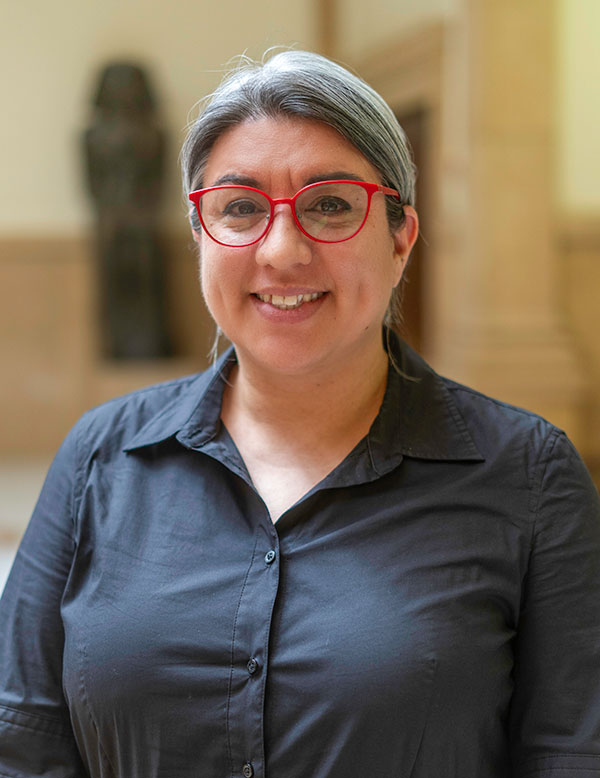 Photo: MATT UNGER
Photo: MATT UNGERIn March, Kathy Hollis joined Carnegie Museum of Natural History as its inaugural director of collections care and access. It’s a position that might seem daunting in its scope: She’ll lead the entire collections team—including nine collection managers—in caring for some 22 million specimens and objects that range from birds and botany to archaeological artifacts and dinosaur fossils. But Hollis has managed gargantuan collections before. Previously, the Ohio native worked for 13 years in Washington, D.C., as the collection manager for paleobiology at the Smithsonian National Museum of Natural History, where she developed and implemented the management strategy for its 40-million-plus-specimens National Fossil Collection. Before that, she was invertebrate paleontology collections manager at the University of Colorado Museum of Natural History.
Hollis, who holds graduate degrees in geology from The Ohio State University and museum studies from University of Colorado Boulder, says she feels privileged to be at Carnegie Museum of Natural History. Her goal is to make the massive collections in the museum’s care—including the most comprehensive record of the nature and culture of western Pennsylvania—more accessible to scientists, students, and the public. “Collections are primary data about the natural world,” she explains. “And if the collections aren’t being accessed or used, then what are they for?”
Q: How did you get in this line of work?
A: I knew the PhD route wasn’t for me, so I started thinking, “What do I love?” I love fossils. I love organizing things. I love supporting scientific research. I started to look for job descriptions and discovered the role of a collections manager, which perfectly captured all my loves.
Q: Is this something you’ve always loved?
A: I have, but my perspective changed during grad school. Before, working in a museum was about escape, about “The world is confusing, but if I work within this collection, I can just be surrounded by these amazing fossils and not really have to think about human problems.” And then in grad school I realized, no, that’s not the point of collections work. It’s actually the opposite. Collections work is about service and connecting people through collections.
Q: What’s it like working with 22 million specimens?
A: In terms of depth and breadth, there are parts of our collection that make us unique among other museums. I’m very honored and humbled to be a part of it, and also to be the first person in this role.
Everyone who works here is amazing, as is their work. But collections management hasn’t had a leader in order to speak with one voice. My job is to figure out how to get the collections team what they need to steward the collections. That’s something I’m very excited about—this transformation, this new future-proofing direction the museum is going.
Q: How do you find it being in Pittsburgh?
A: The pride of this place, and being with a museum that’s an important part of Pittsburgh identity, is really exciting. The Smithsonian, of course, is iconic and amazing, but they weren’t really the region’s museum. I’m very excited to be somewhere so connected to the people who live here.
Q: Have you established a “typical” workday yet?
A: Every day is different. One of the big things we’re working on are ways to improve the physical storage so the collections don’t degrade over time. Collections management is about balancing care and access. It’s a balance between making sure something is protected in perpetuity, like “don’t touch, it will damage it”—but then also access— “use this, touch it, analyze it.”
Then there’s the digital access piece. Getting our collection described and searchable online, and figuring out how to get the collection imaged. We want the collections to be searchable if someone across the globe says, “I need frogs from western Pennsylvania,” they can easily find them. Contributing to the global dataset of natural history collections is a big initiative—the informatics piece.
Q: You’ve always loved fossils. Why?
A: They’re like time machines. Fossils are tangible evidence of what the world was like before humans, in a way that we could only ever know by studying fossils. There’s so much you could learn from them.
Just this morning I was reading about an iconic Burgess Shale fossil. It’s hundreds of millions of years old. These organisms are so well preserved that you could figure out their anatomy and how they lived in a world where there wasn’t even grass. I like to think, “Wow, this thing lived before there were bees flying around.” That’s what I love about fossils—piecing together Earth’s history is imagining a real-life fantasy.
Receive more stories in your email
Sign up